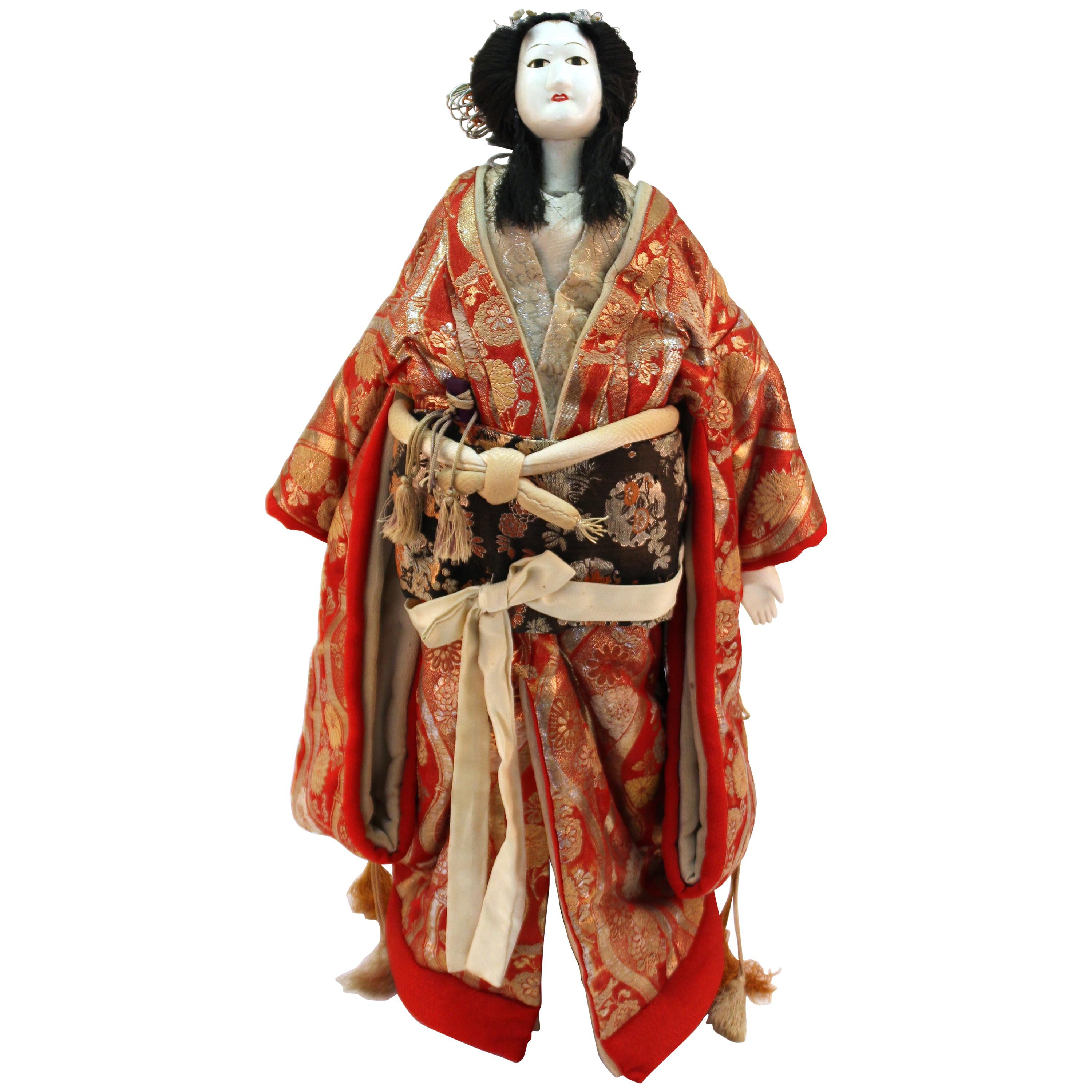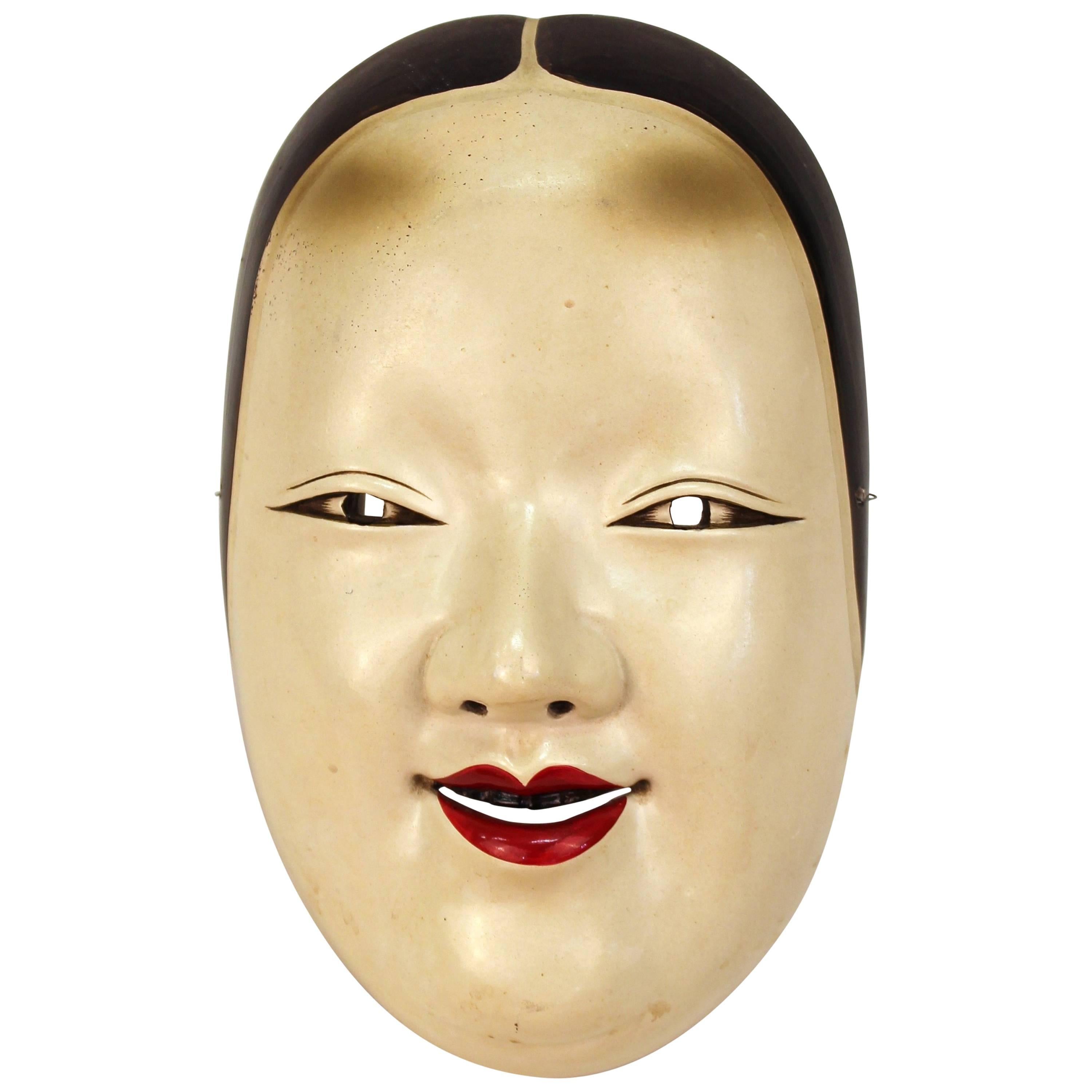Items Similar to Japanese Meiji Noh Mask of Okina
Want more images or videos?
Request additional images or videos from the seller
1 of 12
Japanese Meiji Noh Mask of Okina
About the Item
Japanese carved wood Noh mask depicting Okina. The piece was made during the late Edo - early Meiji period in the 19th century. The mask is of an older man with long white beard, which is a sign of wisdom. The Okina mask takes its origin from the traditional Genryu style of Noh plays called 'Dance of the Monkeys' and features a movable jaw. Signed on the back with a mark. In great vintage condition with age-appropriate wear and use.
- Dimensions:Height: 7.5 in (19.05 cm)Width: 6.5 in (16.51 cm)Depth: 3 in (7.62 cm)
- Style:Meiji (Of the Period)
- Materials and Techniques:
- Place of Origin:
- Period:
- Date of Manufacture:19th Century
- Condition:Wear consistent with age and use.
- Seller Location:New York, NY
- Reference Number:
About the Seller
4.9
Vetted Seller
These experienced sellers undergo a comprehensive evaluation by our team of in-house experts.
1stDibs seller since 2010
2,447 sales on 1stDibs
Typical response time: 2 hours
- ShippingRetrieving quote...Ships From: New York, NY
- Return PolicyThis item cannot be returned.
More From This SellerView All
- Japanese Meiji Noh Mask in Carved WoodLocated in New York, NYJapanese early Meiji period Noh theater mask made of carved wood with gofun layers. The piece was made in Japan in circa 1880 and is signed on the back. In great antique condition wi...Category
Antique 1880s Japanese Meiji Sculptures and Carvings
MaterialsWood
- Japanese Meiji Bunraku Ningyo PuppetLocated in New York, NYJapanese Meiji period puppet for the traditional Bunraku ningyo joruri puppet theater. The piece has a carved wood head and is adorned with richly detai...Category
Antique Early 1900s Japanese Meiji Sculptures and Carvings
MaterialsTextile, Wood
- Japanese Mask of Ko-OmoteLocated in New York, NYA Japanese Noh theatre sculpted wood mask of Ko-Omote, a young girl. The mask was crafted in the early 20th century and is in great vintage condition.Category
Early 20th Century Showa Sculptures and Carvings
MaterialsWood
- Japanese Edo Period Lion MaskLocated in New York, NYA rare Edo period (17th century-18th century) Japanese lion mask for the Gion Festival. This mask was part of a two-man costume, with one man holding the mask and the other at the back covered with fabric to perform the traditional Lion Dance...Category
Antique 17th Century Japanese Edo Sculptures and Carvings
MaterialsWood
- Japanese Edo Period Kyogen Mask of a Nio GuardianLocated in New York, NYAn extremely rare Japanese Edo period Kyogen mask of a Nio guardian king, a ferocious native deity often associated with the Naga Dragon Kings, who convert...Category
Antique 19th Century Japanese Edo Sculptures and Carvings
MaterialsWood
- Japanese Edo Noh Mask of ObeshimiLocated in New York, NYJapanese Edo period carved, lacquered and gilt cypress wood Noh mask of Obeshimi. Made in the circa late 17th century, this extremely rare piece represents th...Category
Antique Late 17th Century Japanese Edo Sculptures and Carvings
MaterialsCypress
You May Also Like
- Noh Edo Period Lion MaskLocated in Pasadena, CAThis a well-preserved lion mask that dates to the 18th century (possibly earlier). Lion masks were used in the traditional Gion Matsuri festival lion dances...Category
Antique Early 18th Century Japanese Edo Sculptures and Carvings
MaterialsWood
- Japanese Edo Period Noh Theater Mask with Red, Black and Golden PatinaLocated in Yonkers, NYA Japanese Edo period "Noh" theater mask from the 17th to 19th century. Created in Japan during the Edo period (1603-1868), this mask captures our attention with its striking expression and contrasting colors. Noh, a form of theater involving music, dance and drama and originating in the 14th century, uses...Category
Antique 19th Century Japanese Edo Sculptures and Carvings
MaterialsWood
- Japan 1890 Meiji Period Signed Assembling of Okimono with a Group of SkeletonsLocated in Miami, FLA signed Okimono from the Japanese Meiji period (1868-1912). Very rare, unusual and large sculptural assembling of a dysplaying piece of okimono. Created in Japan during the imperial period of the Meiji (1868-1912). This extraordinary piece okimono sculpture depict a group of four intricately and realistically rendered carousing males skeletons representations (Gaikotsu) standing in several position. One skeleton is crouched down playing with mouses in the floor. The second is seated resting in the other's back, peacefully smoking opium. The others two are fully standing in interacting position. The entire composition is arranged freely displayed on the wood base including a woven basket, apparently with food and four playfull mouses. There are an extra five mouses in different positions, freely playing around, all of them with the eyes accented with carved black ebony. The composition is displayed on a four-legged free form carved wood platform with an inlaid red plaque engraved with the artist's signature. The level of detail and the quality of the carving is truly exceptional. Has an exact measurements of 216.15 mm by 139.7 mm by 359.41 mm (8.51 x 5.5 x 14.15 Inches). After an extensive collection of data, comparables and references to this piece, we have only been able to find only three okimono sculptures like this, with similar themes and the same quality of work. References Note: A similar carving of four skeletons playing an animated game of dominos, signed Shutaro in an inlaid rectangular red plaque, was sold in London by Christie’s South Kensington in October 14 2014, Lot 120 Sale 5546. References Note: A similar carving with four skeletons in an otherwise typical victorian scene of a photographer and three sitters signed Shutaro in an inlaid rectangular red plaque, was sold in Edinburgh at Lyon & Turnbull in November 7, 2018. References Note: A similar carving with five skeletons seated, playing cards and drinking, was sold in London by John Nicholson Fine Art on September 26, 2018. Meiji period, is an era of Japanese history that extended from October 23, 1868 to July 30, 1912.The Meiji era was the first half of the Empire of Japan, when the Japanese people moved from being an isolated feudal society at risk of colonization by Western powers to the new paradigm of a modern, industrialized nation state and emergent great power, influenced by Western scientific, technological, philosophical, political, legal, and aesthetic ideas. As a result of such wholesale adoption of radically different ideas, the changes to Japan were profound, and affected its social structure, internal politics, economy, military, and foreign relations. The period corresponded to the reign of Emperor Meiji. It was preceded by the Keio era and was succeeded by the Taisho era, upon the accession of Emperor Taisho. Okimono, is a Japanese term meaning for display an ornament; art object; or decorative object, usually displayed in a tokonoma or butsudan "Buddhist altar". It is an ornament or figure, especially one placed in a guest room. An okimono may be a small Japanese carving...Category
Antique 1890s Japanese Meiji Sculptures and Carvings
MaterialsWood
- Tenjin-Sama, Wood, Japanese Shinto Deity of Learning and Wisdom, Meiji PeriodLocated in Point Richmond, CATenjin-Sama, Shinto Deity of Learning and Wisdom, Meiji Period Tenjin,-Sama, Deification of Sugawara no Michizane, was a famous scholar, poet and politician of the Heian period. In...Category
Antique Late 19th Century Japanese Meiji Sculptures and Carvings
MaterialsWood
- Japanese Okina Noh Mask Old Male with Long White Beard Expressing WisdomLocated in Fukuoka, JPSinged Okina Noh mask old male with long white beard expressing wisdom Mid 20 th century Size: 15 x 19 x8 cm ( 6x 7.5 x 3 inch ) Weight: 230g ( 0.5 lb ) Material: wood with go...Category
Mid-20th Century Japanese Showa Sculptures and Carvings
MaterialsWood
- Japan 1890 Meiji Period Ebisu Sculpture in Wood Carving of an Old FishermanLocated in Miami, FLAn extremely well detailed wood carving of Ebisu, as a fisherman. Beautiful and well detailed sculpture, created in Japan during the Meiji dynastic period (1868-1912) back in the 1890's. This piece represent the god of good fortune Ebisu. Was exceptionally carved and executed from one solid single piece of rose wood, showing a gorgeous face expression, with intricate details in the hands and feets, he's carrying as usual a rod and a fish. Ebisu (yebisu), ???, god of fortune, the ocean and fisherman. In the japanese mythology is one of the seven gods of luck, sichi-fuku-jin, the patron of the fisherman and tradesmen. he is depicted as a bearded, smiling fisherman with formal long court ropes, often carrying a rod in one hand and a tai, symbolic fish of the good luck, in the other. The height is 14.25 inches (36.20 cm) and the base measurements is 6.5 by 6.45 inches (16.5 x 16.38 cm). Meiji period, is an era of Japanese history that extended from October 23, 1868 to July 30, 1912.The Meiji era was the first half of the Empire of Japan, when the Japanese people moved from being an isolated feudal society at risk of colonization by Western powers to the new paradigm of a modern, industrialized nation state and emergent great power, influenced by Western scientific, technological, philosophical, political, legal, and aesthetic ideas. As a result of such wholesale adoption of radically different ideas, the changes to Japan were profound, and affected its social structure, internal politics, economy, military, and foreign...Category
Antique 1890s Japanese Meiji Sculptures and Carvings
MaterialsWood
Recently Viewed
View AllMore Ways To Browse
Antique Mask
Mask Antique
Traditional Japanese Furniture
Japanese Style Traditional
Japanesed Carved Wood
Japan Art Carving
Japanese Late Meiji
Antique Japanese Marks
Japanese Antique Marks
Japan Wood Carving
Japanese Wood Carvings
Japanese Wood Carving
Japanese Vintage Sign
Wood Carving Vintage
Carved Wood 19th Century Japanese
Antique Vintage Japanese
Early Wood Mask
Wears A Mask





